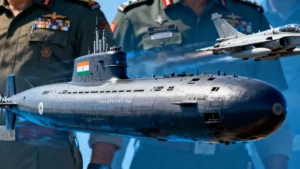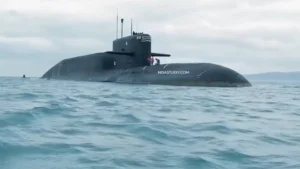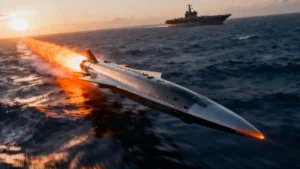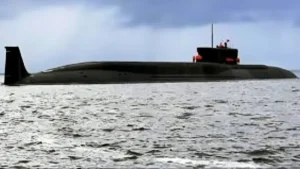India’s vast 7,516-km coastline and expansive Exclusive Economic Zone (EEZ) of over 2 million sq km faces escalating threats from marine pollution and maritime accidents, which surged by 21% in 2024 alone. Rising to meet these challenges, the indigenous Pollution Control Vessel Samudra Prachet, launched by Goa Shipyard Ltd (GSL) in 2025, marks a transformative leap in India’s maritime environmental security. With state-of-the-art oil spill response technology and 72% indigenous content, Samudra Prachet equips the Indian Coast Guard (ICG) with unmatched capabilities to safeguard marine ecosystems and enforce environmental sovereignty.
This vessel not only reflects India’s commitment to Make in India naval vessels but also exemplifies the synergy between defence modernisation and ecological stewardship. For aspiring NDA cadets and defence enthusiasts, understanding Samudra Prachet offers insight into the evolving face of India’s coastal defence and marine security.
Indigenous Pollution Control Vessel Samudra Prachet
On July 23, 2025, Goa Shipyard Limited (GSL) proudly launched the indigenous Pollution Control Vessel, Samudra Prachet. This achievement highlights India’s growing capabilities in defence shipbuilding, reminiscent of the spirit seen during the commissioning of INS Vikrant. With 72% indigenous content, this state-of-the-art vessel exemplifies the ‘Atmanirbhar Bharat’ vision and sets a new standard for India’s maritime self-reliance. The 114.5-meter-long ship, which displaces 4,170 tonnes, is specifically designed to enhance the Indian Coast Guard’s ability to respond quickly and effectively to oil spills and other marine pollution incidents within India’s vast Exclusive Economic Zone (EEZ).
| Specification | Detail |
|---|---|
| Length | 114.5 meters |
| Breadth | 16.5 meters |
| Displacement | 4,170 tonnes |
| Crew Complement | 14 officers and 115 sailors |
| Pollution Control Equipment | Two side-sweeping arms for oil spill recovery, onboard pollutant separation and storage tanks |
| Primary Roles | Pollution control, oil spill response |
| Secondary Roles | Search and rescue, maritime law enforcement, and external firefighting |
| Technology Features | Advanced radar for oil slick detection, pollutant analysis systems |
| Indigenous Content | 72% indigenous components |
| Builder | Goa Shipyard Limited (GSL) |
Primarily built as a pollution control vessel (PCV), Samudra Prachet is equipped with advanced oil spill response systems, including twin side-sweeping arms for efficient oil recovery while underway, pollution analysis units, and onboard tanks to store recovered pollutants. Beyond pollution control, this vessel boasts multi-role capabilities such as search and rescue operations, maritime law enforcement, and external fire-fighting, making it a versatile asset in India’s coastal defence framework.
By combining cutting-edge technology with heavy indigenous integration, the Samudra Prachet launch not only strengthens the Indian Coast Guard’s environmental security role but also propels Goa Shipyard Ltd into the elite league of shipyards building futuristic naval vessels. This marks a proud milestone in India’s journey toward defence modernisation and sustainable maritime security.
What Makes Samudra Prachet a Green Marvel?
The indigenous pollution control vessel, Samudra Prachet, launched by Goa Shipyard Ltd., is not just an ordinary ship; it represents a technologically advanced green initiative for the Indian Coast Guard. This vessel is equipped with cutting-edge systems that extend well beyond basic pollution management. At the forefront of its capabilities are advanced pollution control systems. Samudra Prachet features twin side-sweeping oil containment booms and skimmers that can collect oil slicks even while the vessel is in motion, ensuring rapid and efficient oil spill cleanups. Specialised onboard tanks safely store recovered oil and hazardous substances, preventing secondary contamination. Its ability to manage hazardous and noxious substances (HNS) spills further enhances India’s marine environmental protection capabilities, addressing threats beyond conventional oil pollution.
Additionally, the vessel is equipped with onboard sewage and greywater treatment systems that adhere to strict “zero discharge” norms, reflecting India’s commitment to preserving pristine marine ecosystems. Moreover, in alignment with international maritime pollution standards, Samudra Prachet is designed to comply with MARPOL Annexe VI regulations. It utilises either exhaust gas scrubbers or is optimised for low sulfur fuel oil (limited to 0.5% sulfur starting in 2020), significantly reducing sulfur oxide (SOx) emissions and minimising air pollution from ship operations.
Also Read:
How Kerala’s British F-35B Jet Became a Meme Sensation—And Flew Home After a Month
Pakistan Closes Entire Airspace Amid Missile Test or Military Drill? – Exclusive Expose
Is Pakistan Preparing for Conflict ? NOTAM Raises Red Flags in Central Air Command
BREAKING: India to Test Advanced Counter-Satellite Weapon — Defence Space Agency’s Bold New Step
India’s Massive Drone Swarm Strike on ULFA-I Camps in Myanmar: Surgical Strike 2025
Looking to the future, global maritime frameworks like the IMO’s 2023 strategy on greenhouse gas reduction, including the Energy Efficiency Existing Ship Index (EEXI) and Carbon Intensity Indicator (CII), aim for substantial reductions in shipping emissions. While specific details about the greenhouse gas features of Samudra Prachet have not been publicly disclosed, as a highly advanced vessel, it likely integrates or is designed to include energy-efficient propulsion systems and technologies that aim to lower carbon intensity, positioning it as a near-zero emissions platform in the coming years.
‘Make in India’ and the Strategic Imperative: A Symbol of Self-Reliance
Goa Shipyard Limited (GSL) has launched the indigenous Pollution Control Vessel, Samudra Prachet, as part of India’s Aatmanirbhar Bharat vision for defence manufacturing. GSL, a major public sector company, leads the effort to improve India’s shipbuilding capabilities. It consistently produces advanced vessels designed to meet the country’s maritime needs. With over 70% of its parts made in India, Samudra Prachet highlights innovation and the growing skills of local suppliers and manufacturers. This development helps fill gaps in India’s defence supply chain. Using Indian-made components shows India’s commitment to maritime self-reliance and lessens reliance on foreign technology.
Economically, building this vessel has strengthened local industries and created skilled jobs in Goa and across India. Many small and medium enterprises (SMEs) that make parts, electronics, and pollution control systems benefit from this. This local defence ecosystem boosts the economy and improves India’s industrial and technological capabilities. Strategically, Samudra Prachet is vital for protecting India’s Exclusive Economic Zone (EEZ) in the Indian Ocean Region (IOR). It helps manage marine pollution and protects important ecosystems that support millions of livelihoods. Additionally, the vessel allows India to provide emergency help and environmental support to neighbouring countries. This enhances India’s influence in the region and strengthens its coastal defence abilities.
Samudra Prachet represents much more than just a ship; it symbolises India’s growing maritime and strategic self-reliance.
NDA Study
Samudra Prachet and India’s ‘Blue Economy’ Vision
India’s seas are a treasure trove of economic potential, with over 2.3 million square kilometres of Exclusive Economic Zone (EEZ) supporting fisheries, tourism, shipping, and renewable energy. The concept of the Blue Economy revolves around the sustainable use of these ocean resources to drive economic growth, improve livelihoods, and maintain ecological balance. Sustainable maritime development balances economic needs with the protection of marine ecosystems, crucial for long-term prosperity.
The indigenous Pollution Control Vessel Samudra Prachet, launched by Goa Shipyard Ltd, plays a vital role in advancing India’s Blue Economy vision. Equipped with advanced pollution response systems, it protects fragile coastal and marine environments from oil spills, hazardous substances, and maritime hazards. By swiftly responding to pollution incidents, Samudra Prachet safeguards the marine biodiversity and fisheries that millions of coastal communities rely on, while ensuring safe and clean conditions for shipping and tourism.
1. What is the Samudra Prachet vessel, and why is it important for the Indian Coast Guard?
u003cemu003eSamudra Prachetu003c/emu003e is an indigenous pollution control vessel launched by Goa Shipyard Ltd (GSL) in 2025. It equips the Indian Coast Guard with advanced technology to combat marine pollution, oil spills, and hazardous substance leaks in India’s vast Exclusive Economic Zone (EEZ), significantly enhancing maritime environmental security and national coastal defence.
2. What are the key technological features of the Samudra Prachet pollution control vessel?
The vessel boasts cutting-edge pollution management systems, including twin side-sweeping oil containment booms, skimmers, hazardous substance handling tanks, onboard sewage and greywater treatment systems adhering to zero discharge norms, and compliance with MARPOL Annexe VI standards through exhaust gas scrubbers and low sulfur fuel use. It combines indigenous innovation with global green maritime standards.
3. How does the Samudra Prachet support India’s ‘Make in India’ and self-reliance goals?
With over 70% indigenous content, Samudra Prachet demonstrates India’s growing shipbuilding capabilities through Goa Shipyard Ltd, a public sector shipyard. It supports national self-reliance by boosting local manufacturing, creating skilled jobs, and reducing dependency on foreign defence technology, aligning with the ‘Aatmanirbhar Bharat’ vision.
4. In what ways does the Samudra Prachet contribute to India’s Blue Economy?
The vessel protects marine ecosystems vital to fisheries, tourism, and coastal livelihoods by rapidly responding to pollution threats. It ensures safe navigation and environmental sovereignty within India’s EEZ, supporting sustainable economic growth and resilience of marine resources, which are core to India’s evolving Blue Economy strategy.
5. What multi-role capabilities does Samudra Prachet possess besides pollution control?
Besides pollution response, Samudra Prachet is equipped for search and rescue operations, maritime law enforcement, and external fire-fighting, making it a versatile asset for comprehensive coastal security and humanitarian assistance missions
6. How does Samudra Prachet comply with international environmental standards?
The vessel complies with MARPOL Annexe VI regulations for emission controls, including the use of exhaust gas scrubbers and low sulfur fuel oil limits (0.5% sulfur). It aligns with IMO’s 2023 strategies targeting greenhouse gas reductions, showcasing India’s commitment to global maritime environmental norms.
7. What economic impact does the construction of Samudra Prachet have on India?
The project boosts local economies by creating jobs, supporting MSMEs in defence manufacturing, and advancing technological skill development. It enhances the domestic industrial base in maritime defence production, fostering long-term economic growth and technological self-sufficiency.
Moreover, this vessel integrates seamlessly into India’s broader sustainable maritime framework, reinforcing the commitment to environmental sovereignty and coastal resilience. Beyond direct pollution control, Samudra Prachet enhances India’s ability to manage marine disasters and supports humanitarian efforts, strengthening regional cooperation and security in the Indian Ocean Region.
Why Marine Environmental Security Matters in Your Future?
India's maritime area is crucial for national security, the environment, and the economy. With over 7,500 km of coastline, protecting the marine environment is vital for fisheries and coastal jobs. The Indian Coast Guard’s new Pollution Control Vessel, Samudra Prachet, focuses on environmental security and disaster response. For NDA aspirants and future defence personnel, understanding marine environmental security is essential. This field includes pollution control, law enforcement at sea, and disaster management. Operating vessels like Samudra Prachet demonstrates India's commitment to sustainability and regional influence. Challenges like oil spills and hazardous waste require skilled officers. A career in marine environmental security aligns with India's goal of self-reliance and responsible ocean management, making it important for young people interested in serving their country at sea.
Author’s Word & The Road Ahead
The Indigenous Pollution Control Vessel Samudra Prachet, launched by Goa Shipyard Ltd in 2025, is a significant advancement for India’s maritime environmental security. With over 70% indigenous content, it is designed to address oil spills and marine pollution in India’s Exclusive Economic Zone (EEZ), while also supporting various operations such as search and rescue. The vessel features advanced pollution control systems and adheres to stringent environmental standards. It aligns with the “Make in India” initiative by promoting local manufacturing and creating skilled jobs in the shipbuilding sector. Strategically, it strengthens India’s role in the Indian Ocean Region and underscores the nation’s commitment to a sustainable maritime environment.
Stay Tuned & Stay Connected!
![India’s Indigenous Pollution Control Vessel Samudra Prachet Launched by GSL [2025 Exclusive ] 1 Indigenous Pollution Control Vessel Samudra Prachet](https://ndastudy.com/wp-content/uploads/2025/07/Indigenous-Pollution-Control-Vessel-Samudra-Prachet.webp)











